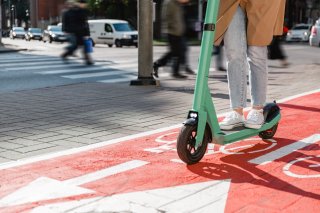Smart Growth Streets and Emergency Response
Communities can use smart growth design solutions to make streets safer for all users – pedestrians, bicyclists, transit riders, drivers and emergency response personnel – through design strategies and solutions such as:

-
Narrowing overly wide streets.
-
Reducing turning radii.
-
Adding sidewalks, bike lanes, on-street parking, and street trees.
-
Improving connections between streets.
Collectively, these strategies can help slow traffic speeds and provide users with multiple routes and travel options.
In some cases, local fire and emergency response officials may express the concern these strategies undermine their ability to provide timely, responsive service. State and local codes often establish minimum street clearance requirements for easy and unobstructed access to emergency response vehicles. Because of these requirements and concerns from emergency responders, some communities have been unable to move forward with smart growth plans.
In response to this tension, EPA worked with local firefighters from across the country, as well as the Congress of New Urbanism, to highlight how connected street networks can improve community health and safety. The resulting report, Saving Lives, Time, Money: Building Better Streets (PDF) (9 pp, 995 K, About PDF) (2009), includes research showing that a highly connected neighborhood network of narrower streets provides health benefits by increasing pedestrian activity. Narrow streets naturally cue drivers to slow down, reducing the severity of injuries and increasing crash victims' odds of survival. Increased street connectivity also improves emergency responders' access, offering multiple route options for answering emergency calls.
Compared to systems dominated by cul-de-sacs, highly connected street networks shorten the physical distance emergency responders have to travel. As most emergency response calls are for medical events rather than fires, these access improvements can significantly enhance the community's overall health and safety.
Emergency Response and Street Design has more information about the project and links to emerging research findings on these issues.
Learn More About Street Design and Emergency Response
- Traffic Calming and Emergency Response (PDF)(4 pp, 1.2 MB, About PDF) discusses retrofitting streets in ways that support emergency response needs.
- Street Design and Emergency Response (PDF)(4 pp, 1.1 MB, About PDF) summarizes good street design strategies and tools for emergency response officials reviewing smart growth developments.
- Emergency Response, Traffic Calming and Traditional Neighborhood Streets addresses concerns that fire departments and other emergency responders have about efforts to calm traffic and build narrower streets, discusses the impact of different treatments on emergency response times, and explains what works and what does not.
- Road Diets and Emergency Response (Federal Highways Administration) describes what a road diet is and how it can lead to safer streets.
